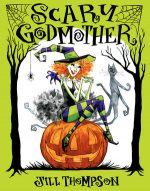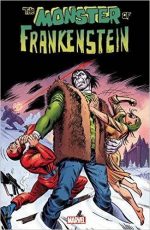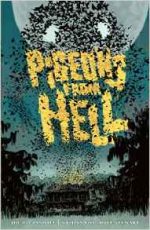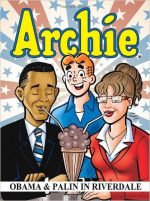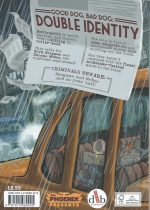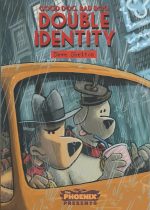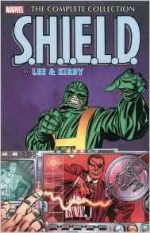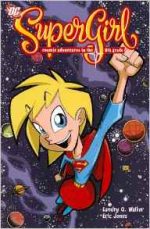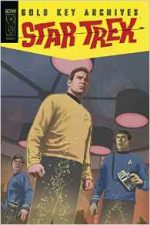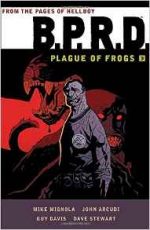
By Mike Mignola, John Arcudi, Guy Davis, Dave Stewart & Clem Robbins (Dark Horse Books)
ISBN: 978-1-59582-860-6 (HC): Â Â Â Â Â 978-1616556228 (PB)
Hellboy is a creature of vast depth and innate mystery; a demonic baby summoned to Earth by Nazi occultists at the end of Word War II but subsequently raised, educated and trained by parapsychologist Professor Trevor “Broom†Bruttenholm to destroy unnatural threats and supernatural monsters as the lead field-agent for the Bureau for Paranormal Research and Defense.
After decades of unfailing, faithful service, in 2001 he became mortally tired and resigned. Itinerantly roaming the world, he still managed to constantly encounter weird happenstances, never escaping trouble or his own sense of duty. He’s only a momentary guest star in this book.
This particular massive tome – available in hardback, paperback and digital formats – in fact stars his trusty comrades: valiant champions of varying shades of human-ness who police those occult occasions which typically fall under the remit of the Enhanced Talents task force of the B.P.R.D.
If you’re having trouble with the concept, think of a government-sanctioned and internationally co-sponsored Ghostbusters dealing with Buffy-style threats to humanity.
The B.P.R.D. rapidly established itself as a viable publishing premise in its own right through a succession of interlinked miniseries; confronting an ancient, arcane amphibian menace to humanity in an immense epic which spanned eight years of comicbook releases.
Previously collected as a series of trade paperbacks during that time, the entire supernatural saga – latterly dubbed Plague of Frogs – was remastered as a quartet of monumental full-colour volumes, of which this is the twisted third.
Gathering material from B.P.R.D. The Universal Machine; Garden of Souls and Killing Ground – volumes 6 through 8 respectively – this macabre masterpiece opens with a handy recap page identifying key personnel of the B.P.R.D.
Then an equally informative Introduction from series editor Scott Allie provides context and background in the organisation’s struggle against the eons-old supernal force mutating humans into terrifying frog-monsters as well as few behind-the-scenes production secrets…
At the end of the previous collection, the team had narrowly avoided the end of the world by finding the Frog citadel and defeating marauding Elder God-made-grisly-flesh Katha-Hem… but at great and tragic cost…
Crafted throughout by writers Mignola and John Arcudi, illustrated by Guy Davis, lettered by Clem Robins and coloured from Dave Stewart, ‘The Universal Machine’ (originally a 5-part miniseries spanning April to August 2006) takes up the story as amphibious Abe Sapien and undead marine Benjamin Daimio oversee the sterilising carpet-bombing of the city the Frog destroyed to summon their archaic eidolon.
Back at their new Colorado base, pyrokinetic Liz Sherman and disembodied psychic Johann Krauss discuss with historian Dr. Kate Corrigan how to resurrect their fallen comrade Roger the Homunculus from the pile of broken rubble he was reduced to…
Despite Roger’s mystical origins that prospect seems unlikely until the B.P.R.D. are offered a copy of legendary alchemical tome “A True Record of the Workings of the Universal Machine†by an enigmatic bookseller in France…
Soon Corrigan and trainee researcher Andrew Devon are in the picturesque village of Ableben, discussing the unnatural events of 1491 which shattered the castle of local lord Marquis Adoet de Fabre and scattered his celebrated collection of monsters, grotesques and magical artefacts…
The bookseller is a weird and difficult cove, clearly more intent on teasing his customers than selling his wares, and when Devon steps outside to report in, Corrigan’s suspicions are proved right.
The vendor is de Fabre himself, laying a trap to abduct her. Whisking Kate back in time, the sinister savant has the book she needs but what he wants in return is a price that cannot be paid…
As Devon quails in the present and in the clutches of a werewolf pack acting as the mage’s 21st century negotiators, back in Colorado the Enhanced Talents squad are sharing coffee and stories. Former Green Beret Daimio at last reveals how he came back from the dead three days after dying in the line of duty…
A covert mission in Central America resulted in the slaughter of him and his team by a jaguar monster. They stayed dead and he didn’t…
Moved by the confession, Johann shares a moment of his former, corporeal, life as a spirit medium: one that only emphasises his own loneliness and moral weakness whilst deeply harming both the living and dead clients he was striving to help…
Liz doesn’t share anything. She’s been acting strange for quite a while now and doesn’t want anyone to know that she’s seeing visions and getting messages from a mystery mage only she can see…
The late night chinwag moves on to pensive Abe, but rather than share his recent life-altering news he prefers to relate the old and sad tale of a family man lost in the Canadian wilderness. By the time he and Hellboy had found Daryl Tynon, the poor slob was well on the way to losing his mind. He had already tasted human flesh and physically transformed into a Wendigo…
Back in the past, the magical collector boasts, brags and bullies. Convinced he has the upper hand, de Fabre shares many of his secrets and displays his greatest prizes, but has grievously underestimated the perspicacity and sheer guts of his merely human hostage…
Victorious but without her prize, Corrigan survives the destruction of de Fabre’s castle and is unceremoniously dumped back in her own time. Although she has failed to find a way to restore Roger, the departed Homunculus has a message for them all, to be delivered by Krauss…
The next volume also started as a 5-issue miniseries. ‘Garden of Souls’ (March to July 2007) concentrates on Abe’s recently uncovered origins and opens in 1859 with psychical researcher Dr. Langdon Everett Caul as part of a group of like-minded men fascinated with arcane secrets. He is present when an Egyptian mummy is unwrapped at a grand soiree. Incredibly, the withered husk was still alive so he and his closest associates in the Oannes Society stole the astonished, outraged ancient Panya, convinced she is the sea goddess Naunet…
More than a century later Abe was found by the B.P.R.D. in a tank; a bizarre fish-human hybrid with no memory of his past. It’s all started coming back to him now, however, especially after being sent Caul’s old cigar case with a map neatly tucked inside…
With Daimio as back-up but still sharing nothing, Abe heads to Balikpapan, Indonesia, unaware that his taciturn companion is concealing a few secrets of his own or that best friend Liz is slowly succumbing to the poisonous whispers of someone no one can see and being driven insane by visions of impending Armageddon…
Despite the passage of time the men of the Oannes Society are still alive. Sustaining themselves through steampunk biomechanics, the sages have been building bio-mechanical monsters whilst growing themselves new superhuman flesh bodies to hold their corrupted minds. They have also been waiting for Caul to return and cannot understand his odd new notions of morality…
They have no idea why he should be so upset at what they did to his original body or their current scheme to catastrophically inundate all of South East Asia and harvest the souls of the millions who will drown.
Happily, Ben is on hand to help defuse the plot, assisted by the astounding psychic powers of the still-captive and extremely resentful living mummy Panya…
This all-action adventure then gives way to suspense and revelation in ‘Killing Ground’ (5 issues once spanning August-December 2007) with change in the air at B.P.R.D.’s Colorado HQ. Johann has taken possession of the last super-body built by the Oannes Society and is becoming increasingly intoxicated by the fleshly sensations he believed denied him forever.
Daimyo is reeling from public revelations that his grandmother was a WWII war criminal, but has managed to keep secret the wizard he periodically sneaks into the base to deal with horrific body changes he doesn’t want his comrades to know about.
Liz is particularly happy. Without being told, new inductee Panya has confirmed the reality of the stranger haunting the harassed pyrokinetic and even offered some suggestions to counter his constant poisonous whispers.
Abe, now officially in charge of the Enhanced team, is overseeing the transfer of now-completely feral Daryl to a newly fortified cell, but cannot help noticing the affect the savage beast has on Daimio…
Trouble is never far away. Soon the base has been infiltrated by a deadly silent intruder whose actions kick off a cascade of disasters, beginning with the escape of Daryl and evisceration of Daimio’s secret wizard. With the base on lockdown and bodies piling up, it’s a time for all hands on deck, but super-strong Johann has vanished.
And then the blizzard hits…
As chaos mounts, the silent intruder finally provides some answers in the most agonising manner imaginable, two separate carnosaurs rip their way through the embattled soldiers on site, another Enhanced team member perishes, a ghostly hero returns and the truth about Daimyo’s death and resurrection are horrifically revealed, leading to a major changing of the guard…
Moreover, even though the War on Frogs seems to be over, the best and worst is yet to come…
Following an Afterword by Arcudi, a wealth of Bonus Features included here comprise comprehensive Sketchbook sections on The Universal Machine, Garden of Souls and Killing Ground – all dutifully annotated by Davis – offering roughs, designs and preliminary artwork from Davis and Mignola
With spectacular supernatural fantasy now a staple of TV and movie genre, these unlikely heroes must be a top pick for every production company out there. Until then, why not stay ahead of the rush by reading these chillingly compelling yarns?
B.P.R.D. ™: Plague of Frogs volume 3 © 2006, 2007, 2008, 2012, 2015 Mike Mignola. Abe Sapien™, Liz Sherman™, Hellboy™, Johann™, Lobster Johnson™ and all other prominently featured characters ™ Mike Mignola. All rights reserved.

